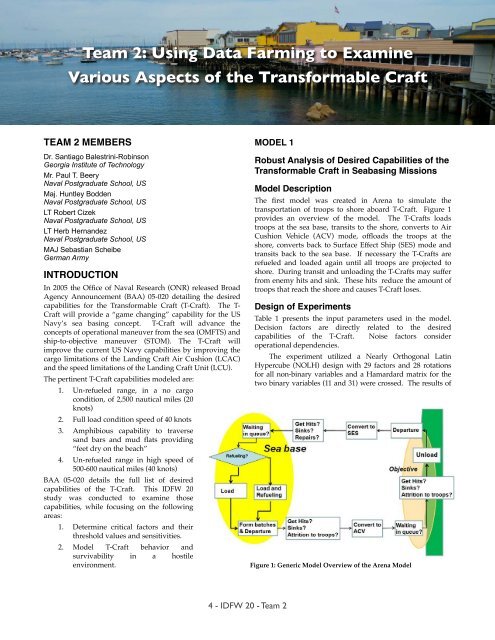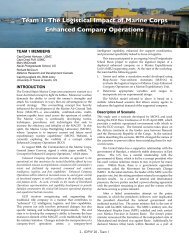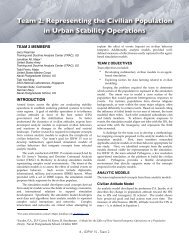pdf file - SEED Center for Data Farming - Naval Postgraduate School
pdf file - SEED Center for Data Farming - Naval Postgraduate School
pdf file - SEED Center for Data Farming - Naval Postgraduate School
You also want an ePaper? Increase the reach of your titles
YUMPU automatically turns print PDFs into web optimized ePapers that Google loves.
Team 2: Using <strong>Data</strong> <strong>Farming</strong> to Examine<br />
Various Aspects of the Trans<strong>for</strong>mable Craft<br />
TEAM 2 MEMBERS<br />
Dr. Santiago Balestrini-Robinson<br />
Georgia Institute of Technology<br />
Mr. Paul T. Beery<br />
<strong>Naval</strong> <strong>Postgraduate</strong> <strong>School</strong>, US<br />
Maj. Huntley Bodden<br />
<strong>Naval</strong> <strong>Postgraduate</strong> <strong>School</strong>, US<br />
LT Robert Cizek<br />
<strong>Naval</strong> <strong>Postgraduate</strong> <strong>School</strong>, US<br />
LT Herb Hernandez<br />
<strong>Naval</strong> <strong>Postgraduate</strong> <strong>School</strong>, US<br />
MAJ Sebastian Scheibe<br />
German Army<br />
INTRODUCTION<br />
In 2005 the Office of <strong>Naval</strong> Research (ONR) released Broad<br />
Agency Announcement (BAA) 05-020 detailing the desired<br />
capabilities <strong>for</strong> the Trans<strong>for</strong>mable Craft (T-Craft). The T-<br />
Craft will provide a “game changing” capability <strong>for</strong> the US<br />
Navy’s sea basing concept. T-Craft will advance the<br />
concepts of operational maneuver from the sea (OMFTS) and<br />
ship-to-objective maneuver (STOM). The T-Craft will<br />
improve the current US Navy capabilities by improving the<br />
cargo limitations of the Landing Craft Air Cushion (LCAC)<br />
and the speed limitations of the Landing Craft Unit (LCU).<br />
The pertinent T-Craft capabilities modeled are:<br />
1. Un-refueled range, in a no cargo<br />
condition, of 2,500 nautical miles (20<br />
knots)<br />
2. Full load condition speed of 40 knots<br />
3. Amphibious capability to traverse<br />
sand bars and mud flats providing<br />
“feet dry on the beach”<br />
4. Un-refueled range in high speed of<br />
500-600 nautical miles (40 knots)<br />
BAA 05-020 details the full list of desired<br />
capabilities of the T-Craft. This IDFW 20<br />
study was conducted to examine those<br />
capabilities, while focusing on the following<br />
areas:<br />
1. Determine critical factors and their<br />
threshold values and sensitivities.<br />
2. Model T-Craft behavior and<br />
survivability in a hostile<br />
environment.<br />
MODEL 1<br />
Robust Analysis of Desired Capabilities of the<br />
Trans<strong>for</strong>mable Craft in Seabasing Missions<br />
Model Description<br />
The first model was created in Arena to simulate the<br />
transportation of troops to shore aboard T-Craft. Figure 1<br />
provides an overview of the model. The T-Crafts loads<br />
troops at the sea base, transits to the shore, converts to Air<br />
Cushion Vehicle (ACV) mode, offloads the troops at the<br />
shore, converts back to Surface Effect Ship (SES) mode and<br />
transits back to the sea base. If necessary the T-Crafts are<br />
refueled and loaded again until all troops are projected to<br />
shore. During transit and unloading the T-Crafts may suffer<br />
from enemy hits and sink. These hits reduce the amount of<br />
troops that reach the shore and causes T-Craft loses.<br />
Design of Experiments<br />
Table 1 presents the input parameters used in the model.<br />
Decision factors are directly related to the desired<br />
capabilities of the T-Craft. Noise factors consider<br />
operational dependencies.<br />
The experiment utilized a Nearly Orthogonal Latin<br />
Hypercube (NOLH) design with 29 factors and 28 rotations<br />
<strong>for</strong> all non-binary variables and a Hamardard matrix <strong>for</strong> the<br />
two binary variables (11 and 31) were crossed. The results of<br />
Figure 1: Generic Model Overview of the Arena Model<br />
4 - IDFW 20 - Team 2




